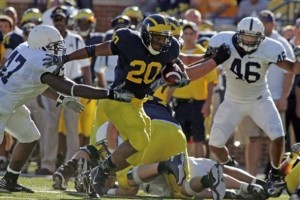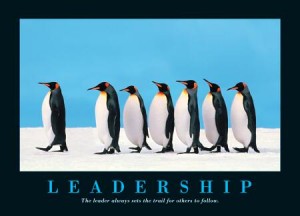OK….the truth is, 111,310 people were watching. And then there was the television audience….probably millions there. They just weren’t watching what I was watching – leadership in all it’s glory.
The date was September 22, 2007, and thanks to a friend’s generosity, I was given tickets to the Michigan-Penn State game. Michigan didn’t have a very good team, but the crowd at the Big House was still amped up. It was a fun atmosphere for me and my then 11 year-old son.
The game was a grinder. Mid-way through the 4th quarter, the score was 7-6 Michigan. The Wolverine offense, quarterbacked by freshman Ryan Mallett, was basically one-dimensional. Team captain Mike Hart finished the game with 44 carries for 153 yards. He was it….the only bright spot on offense.
The Wolverines eventually pushed ahead 14-6, only to see the Nittany Lions come back with a field goal, making the score 14-9. With 6 minutes left in the game, Michigan got the ball and was desperate to run out some clock. They handed the ball to Mike Hart…..and kept handing it to him, over and over again.
With 3 minutes to play, Hart ran up the middle and was destroyed by a Penn State linebacker. It was the 41st carry of the game for the running back, and when he was carried off the field, there was a sense of dread in the crowd. Their leader was gone.
Penn State called a timeout. It was 3rd and 3, and without Hart, you could sense the Nittany Lions thought they could stop Michigan, get the ball back and put the game away. That’s when I watched the drama unfold on the sidelines. Hart had positioned himself away from the coaches, and just before the timeout was over, he limped onto the field and told the running back who had replaced him to go back to the sideline. When he lined up in the backfield, I think everyone, including the coaches, looked on in shock.
Hart knew what was coming, and he did his job perfectly. At the snap of the ball, the Penn State defense blitzed their linebackers, hoping to catch the freshman quarterback off-guard and cause an interception, a fumble, or at the very least, an incomplete pass. As Mallett faded back, the injured Hart stepped in front of the linebacker just before he reached Mallett, and he crushed the defender and put him flat on his back. Pass complete, 1st down, game essentially over.
Mike Hart, who could hardly walk, came back on the field at the perfect moment.
To block. For someone else.
I have watched a lot of football in my life, but I will remember that play as long as I have a memory. THAT was leadership.
And at least one person was watching.





 But the time you’re being given is a gift! Remember, the woodsman never wastes his time when he stops to sharpen his ax.”
But the time you’re being given is a gift! Remember, the woodsman never wastes his time when he stops to sharpen his ax.”  I was in my last year or two of high school when my parents bought their first microwave. It was so exciting! For a child of the 60’s and 70’s, I felt like I had just entered the Star Trek era. In goes frozen food – out comes a beautifully prepared, delicious meal.
I was in my last year or two of high school when my parents bought their first microwave. It was so exciting! For a child of the 60’s and 70’s, I felt like I had just entered the Star Trek era. In goes frozen food – out comes a beautifully prepared, delicious meal. I can’t remember when I first heard it, but there’s an old, oft quoted anecdote that I love. A father and his son entered the dean’s office at the university the younger man was to enter. The father told the dean that he wanted his son to graduate as quickly as possible so as to embark on his career. “How fast can we make it happen?”, he asked. The dean paused and said, “Sir, when God wants to make a squash, He takes three months. When He crafts an oak tree, He takes 100 years. Which would you like your son to be?”
I can’t remember when I first heard it, but there’s an old, oft quoted anecdote that I love. A father and his son entered the dean’s office at the university the younger man was to enter. The father told the dean that he wanted his son to graduate as quickly as possible so as to embark on his career. “How fast can we make it happen?”, he asked. The dean paused and said, “Sir, when God wants to make a squash, He takes three months. When He crafts an oak tree, He takes 100 years. Which would you like your son to be?”